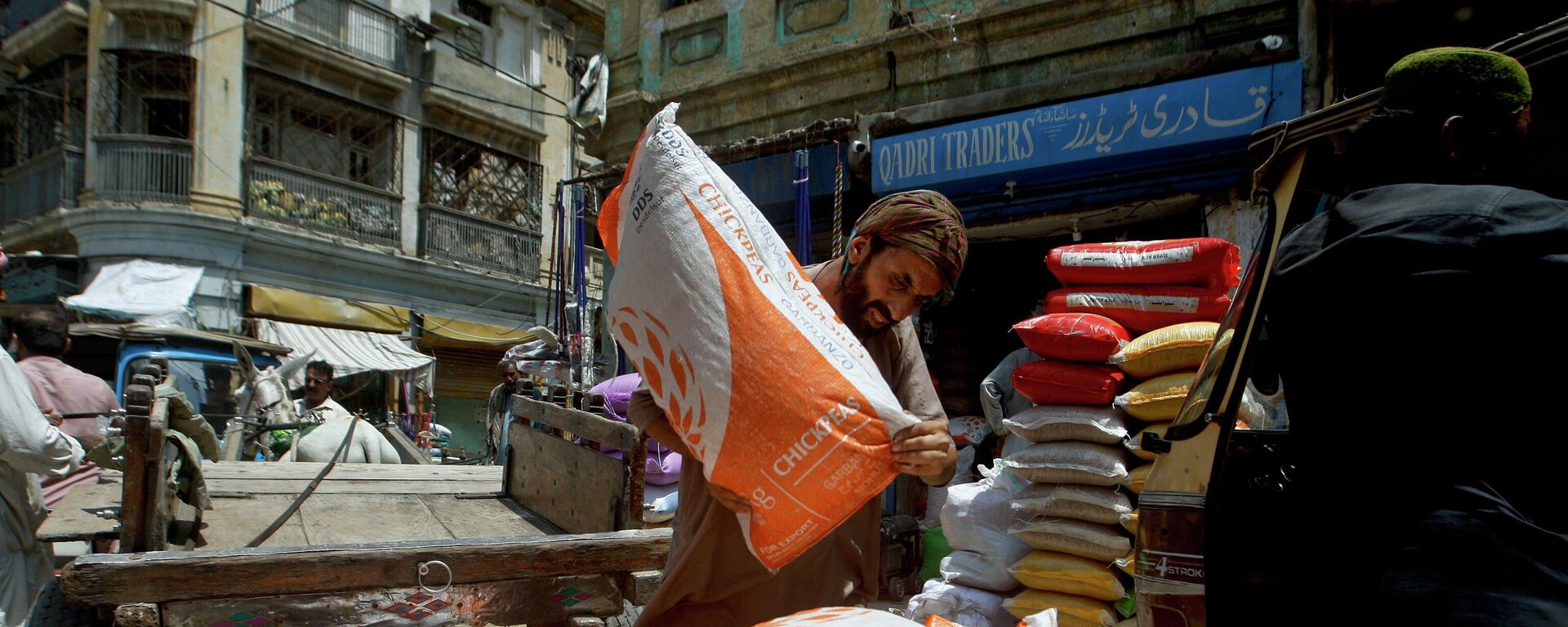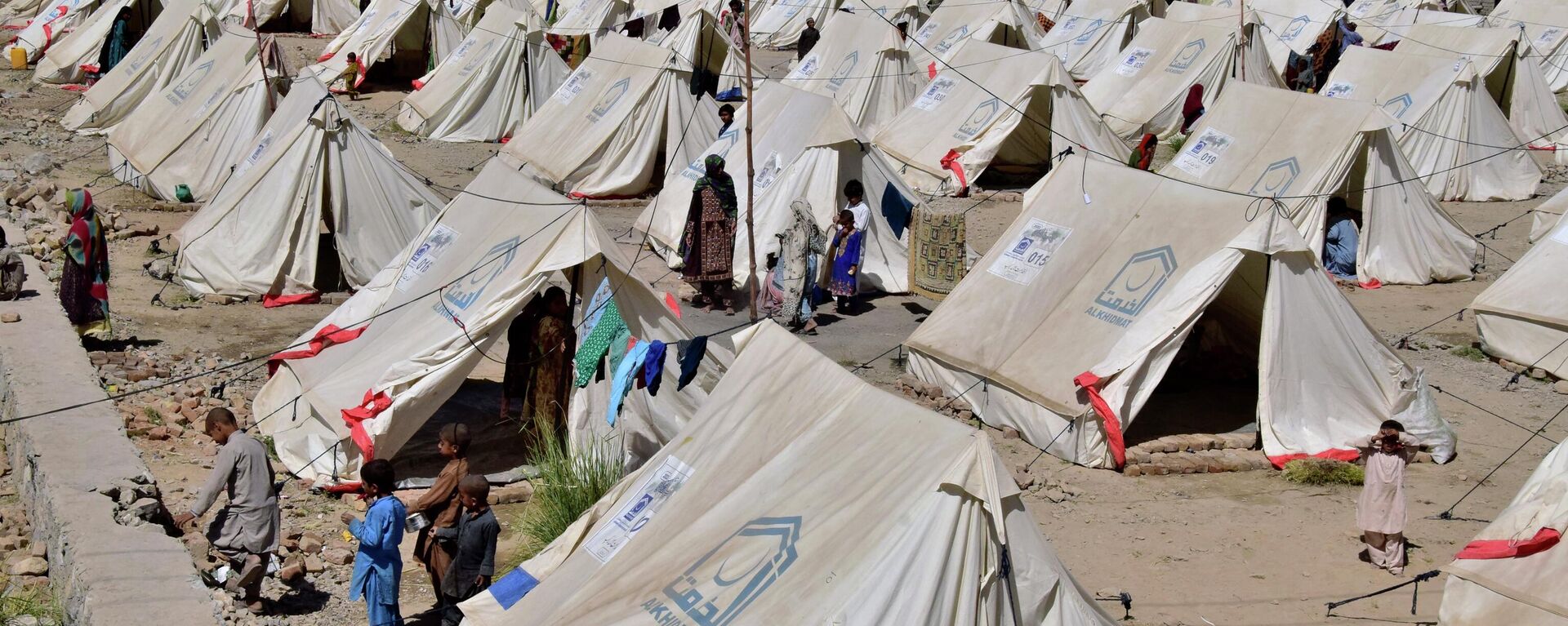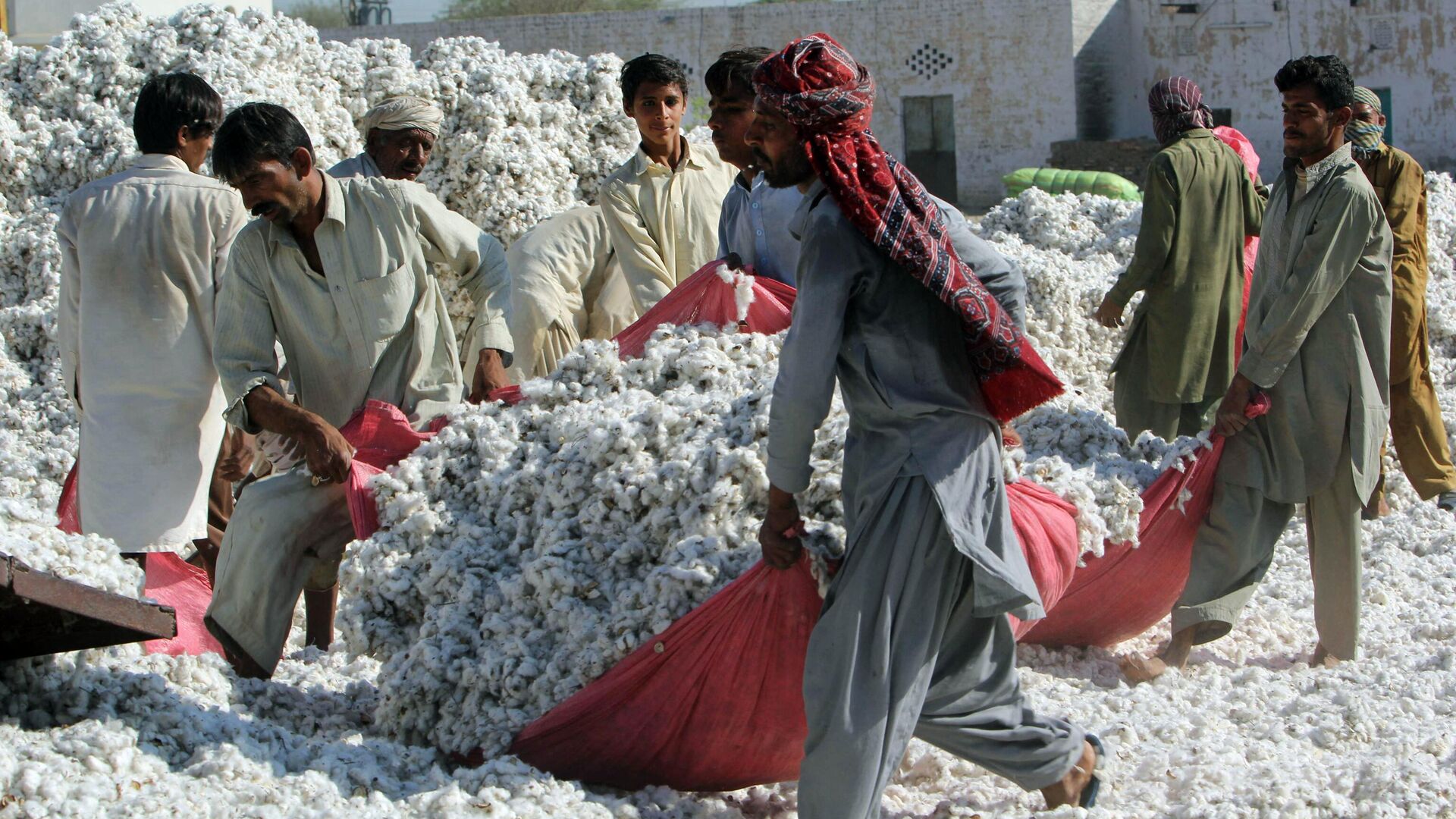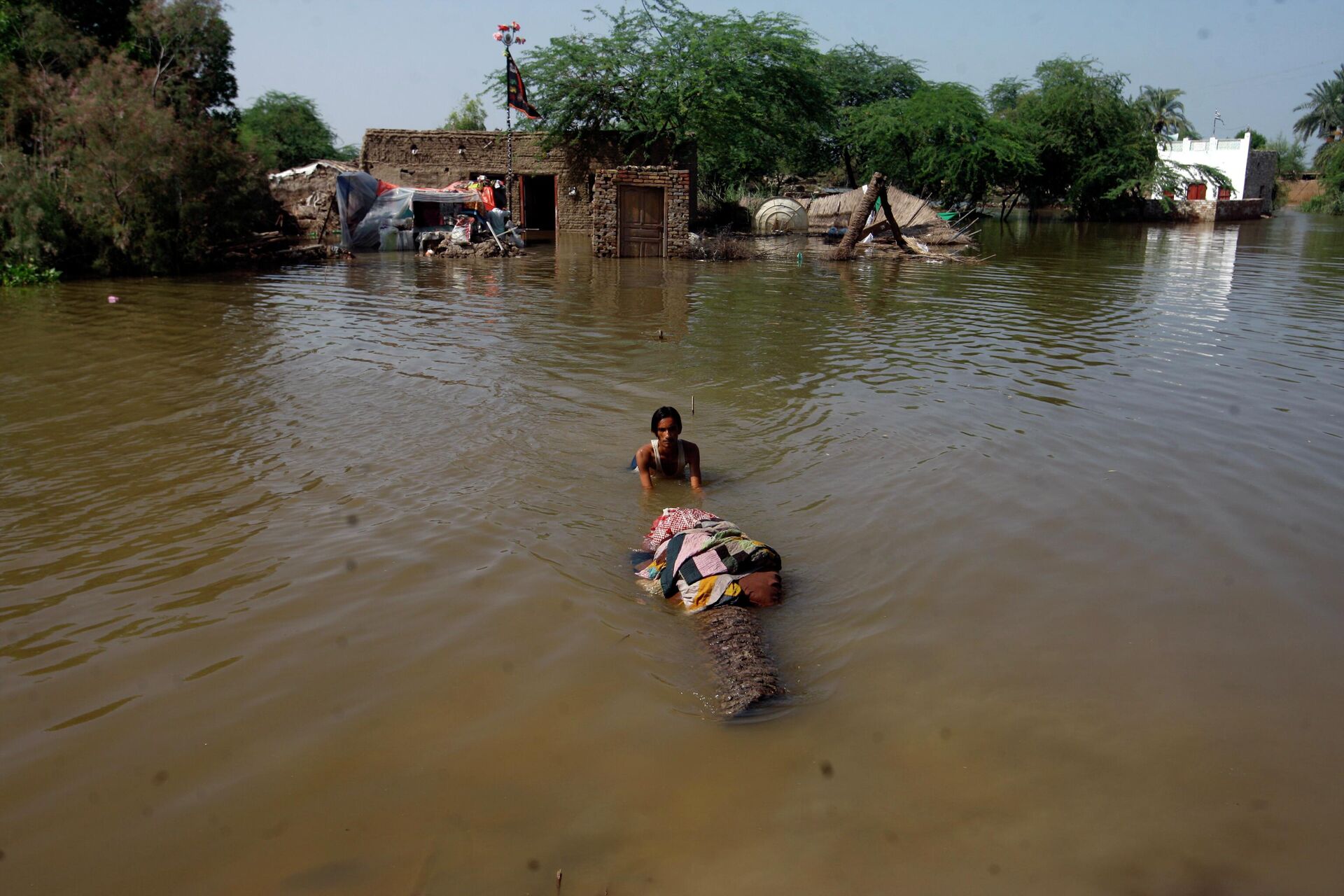https://sputnikglobe.com/20220926/worlds-fifth-largest-cotton-producer-in-peril-1101232297.html
World's Fifth Largest Cotton Producer in Peril
World's Fifth Largest Cotton Producer in Peril
Sputnik International
Extreme weather is causing a global cotton crisis, and Pakistan is at the forefront. Recent floods have wreaked havoc on the country’s cotton industry which... 26.09.2022, Sputnik International
2022-09-26T11:36+0000
2022-09-26T11:36+0000
2023-02-14T08:48+0000
india
pakistan
cotton
floods
https://cdn1.img.sputnikglobe.com/img/07e6/09/1a/1101231466_0:297:3072:2025_1920x0_80_0_0_7d87608f14a3f4d3b4a2b732138f3878.jpg
Pakistan's textile industry is primarily built upon cotton production and harvesting. It is the fifth largest global producer of cotton and this allows it to be a major cotton apparel supplier to western markets.However, over the past few months, cotton factories in the country have been deeply affected by catastrophic floods that have displaced 33 million people and destroyed infrastructure.Many cotton factories were flooded with waist-high water, and in the provinces of Sindh and Balochistan standing cotton crops were demolished by water, with many small nearby mills forced into partial operability or complete closure.This is devastating news for the country's economy, as Pakistan has one of the largest cotton-textile sectors, accounting for 11% of the GDP and 60% of export receipts, according to a report by International Food Policy Research Institute (IFPRI).Cotton is the largest segment of Pakistan's textile production. Other fibers produced include synthetic fiber, filament yarn, art silk, wool, and jute, but cotton spinning is perhaps the most important segment in the Pakistan textile industry with over 521 installed units.Pakistan supplies weaved and knitted apparel, as well as socks and towels to major brands around the world, including Puma, Nike, Ralph Lauren, Dorma, Warner Bros, Next, M&S, Bed Bath & Beyond, Macy’s, Zara, Mango, Levies and Hugo Boss.The country exported textile products worth $19.33 billion during the fiscal year 2021/2022, marking an increase of 25 % compared to the $15.4 billion exported in the preceding fiscal year, according to data released by the Pakistan Bureau of Statistics (PBS).However, since the devastating floods, Pakistan's cotton industry has taken a direct hit and this comes at an already challenging time for the global cotton market.Cotton Crisis WorldwideGlobally this year, cotton is in short supply. The reason for this is extreme weather. It is wreaking havoc upon the world’s largest cotton suppliers.In India, the largest producer of cotton, heavy rains and pests have affected cotton crops so much that the country has to increase cotton imports. A heat wave in China, the second largest cotton producer, is also raising alarm about the upcoming harvest season.Meanwhile, in the US, the third-largest exporter of the commodity, a severe drought is tormenting cotton farms, as predictions suggest that cotton will be at its lowest level in more than a decade.Brazil, which is the fourth-largest cotton exporter, is also struggling with extreme heat and drought that have already cut yields by nearly 30%. Around 200,000 metric tons of cotton have dried up, according to Abrapa, a group representing Brazil's cotton growers.Some of the items that are made using cotton include clothes, sheets, towels, bedding, upholstery fabrics, and rugs. Mega factories and hundreds of millions of people are involved in the production of these commodities, so when cotton supply falls, the textile industries and their employees suffer.According to Warren Shoulberg, a furnishings industry academic, "No matter where you look, cotton is in crisis. It’s quite likely that the 2022 cotton crop, whose harvest runs from now through November, could be as much as a third less than last year’s and one of the smallest outputs in recent memory."As the supply of cotton falls, prices of cotton-made commodities go up, resulting in further inflation which is already sky high in many countries around the world."Usually when economists begin cautioning about a recession, one of the first impacts we see is a reduction in cotton consumption. The relationship is quite simple. When times are tough, clothing and furnishings become discretionary. People will put off buying new garments until times are better; corporations may delay refurbishments that include new rugs, drapes and fabric-based furniture," according to market analyst, Barani Krishnan for Investing.com.Pakistan's Rising Import of CottonCountries like Pakistan whose textile industries make up a large portion of its GDP, suffer the most when crops are destroyed by a calamity. The industry provides direct employment to tens of millions of people in the country.For Pakistan, the damages to the textile industries will give rise to unemployment which will further affect the already fragile economy. The country's foreign-exchange reserves shrunk by more than half in August to just over $9 billion, about six weeks’ worth of imports.Its currency, the rupee, lost 24% of its value against the dollar in 2022. The rising cost of living, flood damages worth billions of dollars and high unemployment are causing much distress to the population.Hence, because of the decline in the cotton crop because of the floods and due to previously existing shortcomings of the textile industry, Pakistan is forced to purchase cotton from other countries to meet its domestic needs.However, because the global prices of cotton have risen exponentially, it is becoming too expensive for Pakistan to import foreign cotton. Following Covid-19 pandemic, the prices have further gone up."We will need to import approximately 70 million bales of cotton this year. Mills will also find that if the yarn is not available cheaply, they will go to lower production or switch to an alternative fiber if it becomes cheaper. This will decrease our competitiveness on the international market," according to Asif Khalil, chairman of the Pakistan Cotton Ginners Association.Challenges Faced by Local Cotton IndustriesCurrently, there is a lack of proper research by Pakistani institutes into cotton crop production. Due to this, there is no sustainable cotton policy and little implementation of the latest seed technology."As the government of Pakistan does not own any cotton farms, most of the banks do not lend money to farmers anyway, so there are no companies that supply farmers with what they need," according to journalist Abdullah Niazi.He further said that the government of Pakistan is not a direct participant in the cotton supply chain and therefore applies no policies designed to benefit cotton farmers or the cultivation of cotton more widely.Furthermore, over the past few years, Pakistan has faced a large-scale energy crisis, which also affects the cotton industry negatively.Due to energy demand exceeding the supply, the government manages the deficit through power cuts (or blackouts). These power cuts, that last several hours in some cities, have significantly impacted manufacturing industries in Pakistan, with thousands of workers taking to the streets in protests.However, there are some who believe that the government has indeed invested a large amount of money into research and technology to improve production and procedures at the textile mills, but has turned a blind eye to some wrongdoings of these companies."There are safety and product standards that are routinely ignored by textile companies. Poor working conditions and insufficient monitoring of labor practices are among the infractions. Several international organizations have threatened to promote sanctions against Pakistani textiles if the government does not force companies to revise their protocols and policies," according to a History of the Textile Industry of Pakistan report.The views and opinions expressed in this article do not necessarily reflect official position of Sputnik
https://sputnikglobe.com/20220920/soaring-energy-prices-force-pakistani-industrialists-to-close-businesses-1101010917.html
https://sputnikglobe.com/20220919/pakistan-fm-confident-of-averting-debt-default-despite-flood-induced-economic-pressure---report-1100949657.html
https://sputnikglobe.com/20220916/least-developed-countries-group-to-press-for-fund-for-global-warming-compensation-at-cop27-1100883417.html
pakistan
Sputnik International
feedback@sputniknews.com
+74956456601
MIA „Rossiya Segodnya“
2022
Aneela Rashid
https://cdn1.img.sputnikglobe.com/img/07e6/09/0e/1100768477_0:338:606:944_100x100_80_0_0_af078d1bbaf1e33c21f16169e9ed7a5f.jpg
Aneela Rashid
https://cdn1.img.sputnikglobe.com/img/07e6/09/0e/1100768477_0:338:606:944_100x100_80_0_0_af078d1bbaf1e33c21f16169e9ed7a5f.jpg
News
en_EN
Sputnik International
feedback@sputniknews.com
+74956456601
MIA „Rossiya Segodnya“
Sputnik International
feedback@sputniknews.com
+74956456601
MIA „Rossiya Segodnya“
Aneela Rashid
https://cdn1.img.sputnikglobe.com/img/07e6/09/0e/1100768477_0:338:606:944_100x100_80_0_0_af078d1bbaf1e33c21f16169e9ed7a5f.jpg
india, pakistan, cotton, floods
india, pakistan, cotton, floods
World's Fifth Largest Cotton Producer in Peril
11:36 GMT 26.09.2022 (Updated: 08:48 GMT 14.02.2023) Longread
Extreme weather is causing a global cotton crisis, and Pakistan is at the forefront. Recent floods have wreaked havoc on the country’s cotton industry which may potentially leave millions of people jobless.
Pakistan's textile industry is primarily built upon cotton production and harvesting. It is the fifth largest global producer of cotton and this allows it to be a major cotton apparel supplier to western markets.
However, over the past few months, cotton factories in the country have been deeply affected by
catastrophic floods that have displaced 33 million people and destroyed infrastructure.
Many cotton factories were flooded with waist-high water, and in the provinces of Sindh and Balochistan standing cotton crops were demolished by water, with many small nearby mills forced into partial operability or complete closure.
All of this resulted in an unprecedented financial loss to Pakistan's cotton industry. According to a report by Servir, the country has lost some $485 million worth of cotton.
This is devastating news for the country's economy, as Pakistan has one of the largest cotton-textile sectors, accounting for 11% of the GDP and 60% of export receipts, according to a report by International Food Policy Research Institute (IFPRI).

20 September 2022, 14:57 GMT
Cotton is the largest segment of Pakistan's textile production. Other fibers produced include synthetic fiber, filament yarn, art silk, wool, and jute, but cotton spinning is perhaps the most important segment in the Pakistan textile industry with over 521 installed units.
Pakistan supplies weaved and knitted apparel, as well as socks and towels to major brands around the world, including Puma, Nike, Ralph Lauren, Dorma, Warner Bros, Next, M&S, Bed Bath & Beyond, Macy’s, Zara, Mango, Levies and Hugo Boss.
The country exported textile products worth $19.33 billion during the fiscal year 2021/2022, marking an increase of 25 % compared to the $15.4 billion exported in the preceding fiscal year, according to data released by the Pakistan Bureau of Statistics (PBS).
However, since the devastating floods, Pakistan's cotton industry has taken a direct hit and this comes at an already challenging time for the global cotton market.
Globally this year, cotton is in short supply. The reason for this is extreme weather. It is wreaking havoc upon the world’s largest cotton suppliers.
In India, the largest producer of cotton, heavy rains and pests have affected cotton crops so much that the country has to increase cotton imports. A heat wave in China, the second largest cotton producer, is also raising alarm about the upcoming harvest season.
Meanwhile, in the US, the third-largest exporter of the commodity, a severe drought is tormenting cotton farms, as predictions suggest that cotton will be at its lowest level in more than a decade.
Brazil, which is the fourth-largest cotton exporter, is also struggling with extreme heat and drought that have already cut yields by nearly 30%. Around 200,000 metric tons of cotton have dried up, according to Abrapa, a group representing Brazil's cotton growers.
As some economic analysts point out: cotton has been taken for granted as a crop, despite the fact that much of the world greatly depends on its production and its shortages may lead to severe economic problems.
Some of the items that are made using cotton include clothes, sheets, towels, bedding, upholstery fabrics, and rugs. Mega factories and hundreds of millions of people are involved in the production of these commodities, so when cotton supply falls, the textile industries and their employees suffer.
According to Warren Shoulberg, a furnishings industry academic, "No matter where you look, cotton is in crisis. It’s quite likely that the 2022 cotton crop, whose harvest runs from now through November, could be as much as a third less than last year’s and one of the smallest outputs in recent memory."
As the supply of cotton falls, prices of cotton-made commodities go up, resulting in further inflation which is already sky high in many countries around the world.
"Usually when economists begin cautioning about a recession, one of the first impacts we see is a reduction in cotton consumption. The relationship is quite simple. When times are tough, clothing and furnishings become discretionary. People will put off buying new garments until times are better; corporations may delay refurbishments that include new rugs, drapes and fabric-based furniture," according to market analyst, Barani Krishnan for Investing.com.
Pakistan's Rising Import of Cotton
Countries like Pakistan whose textile industries make up a large portion of its GDP, suffer the most when crops are destroyed by a calamity. The industry provides direct employment to tens of millions of people in the country.

19 September 2022, 10:25 GMT
For Pakistan, the damages to the textile industries will give rise to unemployment which will further affect the already fragile economy. The country's foreign-exchange reserves shrunk by more than half in August to just over $9 billion, about six weeks’ worth of imports.
Its currency, the rupee, lost 24% of its value against the dollar in 2022. The rising cost of living, flood damages worth billions of dollars and high unemployment are causing much distress to the population.
Hence, because of the decline in the cotton crop because of the floods and due to previously existing shortcomings of the textile industry, Pakistan is forced to purchase cotton from other countries to meet its domestic needs.
However, because the global prices of cotton have risen exponentially, it is becoming too expensive for Pakistan to import foreign cotton. Following Covid-19 pandemic, the prices have further gone up.
"We will need to import approximately 70 million bales of cotton this year. Mills will also find that if the yarn is not available cheaply, they will go to lower production or switch to an alternative fiber if it becomes cheaper. This will decrease our competitiveness on the international market," according to Asif Khalil, chairman of the Pakistan Cotton Ginners Association.
Challenges Faced by Local Cotton Industries
Currently, there is a lack of proper research by Pakistani institutes into cotton crop production. Due to this, there is no sustainable cotton policy and little implementation of the latest seed technology.
"As the government of Pakistan does not own any cotton farms, most of the banks do not lend money to farmers anyway, so there are no companies that supply farmers with what they need," according to journalist Abdullah Niazi.
He further said that the government of Pakistan is not a direct participant in the cotton supply chain and therefore applies no policies designed to benefit cotton farmers or the cultivation of cotton more widely.
Furthermore, over the past few years, Pakistan has faced a large-scale energy crisis, which also affects the cotton industry negatively.

16 September 2022, 20:46 GMT
Due to energy demand exceeding the supply, the government manages the deficit through power cuts (or blackouts). These power cuts, that last several hours in some cities, have significantly impacted manufacturing industries in Pakistan, with thousands of workers taking to the streets in protests.
However, there are some who believe that the government has indeed invested a large amount of money into research and technology to improve production and procedures at the textile mills, but has turned a blind eye to some wrongdoings of these companies.
"There are safety and product standards that are routinely ignored by textile companies. Poor working conditions and insufficient monitoring of labor practices are among the infractions. Several international organizations have threatened to promote sanctions against Pakistani textiles if the government does not force companies to revise their protocols and policies," according to a History of the Textile Industry of Pakistan report.
If the proper investment is allocated to upgrading the cotton industries, managing power outages and if farmers' needs are met, it is quite possible that Pakistan can once again go back to its cotton glory days, and supply the global market with high-end cotton products.
The views and opinions expressed in this article do not necessarily reflect official position of Sputnik







